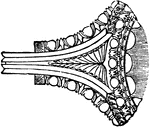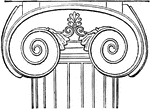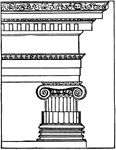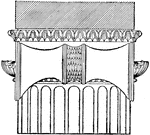Clipart tagged: ‘greek ionic order’

Ionic Antæ Capital from the Temple of Minerva Polias at Athens
The capital of the antæ and pilasters is without volutes, as is seen here. The shaft has no flutings;…

Plan of Ionic Antæ Capital from the Temple of Minerva Polias at Athens
The capital of the antæ and pilasters is without volutes, as is seen here. The shaft has no flutings;…

Ionic Capital from the Temple of Apollo at Basse
In the capital the Doric echinus is replaced either by a cyma ornamented with leaves, or, more generally,…

Greek Ionic Order
The Ionic order column originated in the mid-6th century BC in Ionia. The Ionic order column was being…

Greek Ionic Order (Side View)
The Ionic order column originated in the mid-6th century BC in Ionia. The Ionic order column was being…